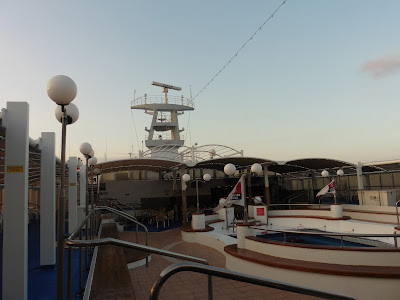17 January 2016
MORE FERRYING IN '15 Part 2
Tuesday 15th September 2015
Oh, the pleasure of a longer lie-in on board BLUE HORIZON this morning; the ship arrived in Heraklion port in Crete at 6.00 a.m. but passengers can stay on board until 8.30 a.m. and this is what we did.
Blue Horizon at Heraklion
We disembarked easily at 8.40 a.m. from a deserted ship and were soon walking into the Bus Station nearby to leave our bags safely locked up for the day. A short walk along the waterside offered nowhere for a breakfast, so we continued along
past some ruins which were being renovated
until we arrived at the familiar Hotel Kornos, where we knew that the proprietor would welcome anyone, hotel residents or non-residents, who wanted breakfast. He was still there and welcomed us for a meal.
We had decided to visit the famous Knossos Palace ruins, which are a few miles inland from Heraklion; by this time the temperature was 30⁰C and climbing so hats, scarves and sunglasses were the order of the day, according to signs advertising a visit. The local bus number 2 soon left and we headed a short way inland to the hills.
Plan of Knossos Palace
There is always an apparently sleeping dog...
Knossos Palace is the largest Bronze Age archaeological site on Crete and is considered Europe's oldest city. The site was discovered in 1878 by Minos Kalokairinos and various coins were found in the earth of this fertile hillside valley. The excavations in Knossos began in AD 1900 by the English archaeologist Sir Arthur Evans (1851–1941) and his team, and they continued for 35 years. The palace was excavated and partially restored under the direction of Arthur Evans in the earliest years of the 20th century; there is a bust of him near the entrance to the ruins. Our lovely lady guide told us that the palace of Knossos was undoubtedly the ceremonial and political centre of the Minoan civilisation and culture. It appears as a maze of workrooms, living spaces, and storerooms close to a central square. An approximate graphic view of some aspects of Cretan life in the Bronze Age is provided by restorations of the palace's indoor and outdoor murals, as it is also by the decorative motifs of the pottery and the insignia on the seals and ceilings.
Sir Arthur Evans
Our guide told us that the palace was abandoned at some unknown time at the end of the Late Bronze Age, c. 1380–1100 BC. Sir Arthur discovered two ancient tablet scripts which he called Linear A and Linear B and one of these was later translated. The palace of Knossos was undoubtedly the ceremonial and political centre of the Minoan civilisation and culture.
Ruins
Hillside down to the stream
Decorative
North pillar hall
We walked around the ruins in the hot sun and stood under trees when we could; the whole area uncovered is about 3.9 square miles, and I think we saw a lot of it. Our guide ended the tour back at the entrance and our small group thanked her very much. The inevitable souvenir shop offered expensive copies of the finds from the excavations, but we visited a little cave-like local shop outside and I treated myself to a beautiful silver and lavender-coloured bracelet instead. When worn, it will be my reminder of an unforgettable visit to Knossos Palace ruins; the first settlement there dates to about 7,000 BC and the first palace dates to 1,900 BC.
Back on the local bus, sitting near the cheerful lady guide, we returned to Heraklion and waved to our guide as she went home. We had time to walk around the town and enjoy local sights such as the Town Hall and then Minoan Lines Head Office, which was rather splendid inside.
As a matter of personal interest, today we have visited the site after which one of the Minoan ships was named - KNOSSOS PALACE - and this evening of course we are sailing on another of their vessels - FESTOS PALACE. Festos, or Phaistos in Greek, is also a Bronze Age site on the island of Crete, first located in 1853, which proved to be a Palace and then belonged to the Mycenaean Greeks.
We reclaimed our bags from the Bus station, walked along to the Minoan Lines terminal for our 6.30 p.m. check in and boarded the huge FESTOS PALACE. She was built in 2001 at 24,352 gross tons. There was time to take photographs before darkness fell, shower and change, and then enjoy the golden hour with a gin and tonic in the King Radamanthys Bar.
Festos Palace
Snack Bar area
King Radamanthys Lounge
One of the long accommodation corridors
Pool and Pool Bar
Builders plate
Deck at dusk
The funnel
Inside the Asterion Pool Bar
Another view of the funnel
Blue Horizon at sunset
High Speed 4 in darkness
Although a big ship, the design flows nicely through and around the comfortable public rooms and art work on board.
Some of the artwork on board
More artwork I liked
Restaurant dinner was interesting for the inevitable huge portions and the horrible-tasting wine recommended by the steward.
Festos Palace Reception (in palatial surroundings, of course)
My bed soon called, and my Cretan day ended with happy memories. Tomorrow we arrive back in Piraeus, at an early hour of 6 a.m. with plans for an extremely short stay on land!
Ships seen: Blue Horizon, Festos Palace, Champion Jet 1, High Speed 4
To be continued...
























